Colloquia for Fall 2020
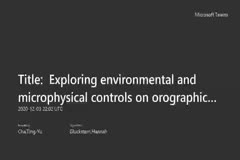
Exploring environmental and microphysical controls on orographic precipitation
December 03, 2020
Annareli Morales, from NCAR
Hosted by Russ Schumacher
Orographic precipitation provides a substantial source of freshwater to communities worldwide, while also posing hydrometeorological and socioeconomic risks. Understanding where, how much, and what type of precipitation will occur remains a forecasting challenge. The environmental conditions upstream of a topographical barrier can bring the ingredients necessary for precipitation, but once…
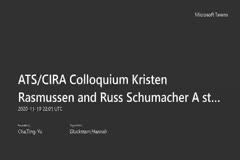
A storm safari in Subtropical South America: proyecto RELAMPAGO
November 19, 2020
Kristen Rasmussen and Russ Schumacher
Hosted by
In 2018-19, a major field campaign named Remote sensing of Electrification, Lightning, And Mesoscale/microscale Processes with Adaptive Ground Observations, or RELAMPAGO (which means lightning flash in Spanish and Portuguese) took place in Argentina and Brazil. The project was a multinational collaboration aimed at answering scientific questions about some of the most intense convective storms…
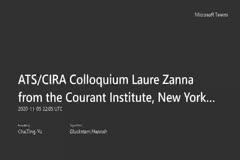
Machine learning for physics-discovery and climate modeling
November 05, 2020
Laure Zanna, from the Courant Institute, New York University
Hosted by Elizabeth Barnes
Over the past few years, machine learning (ML) has been successfully applied to a wide range of climate problems. In particular, ML is being used to replace traditional physics-driven parameterizations of unresolved processes in climate models. In this talk, I will discuss the potential of combining physics and ML algorithms to advance the field of climate science and modeling. I will focus on…
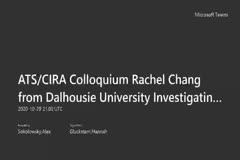
Investigating aerosol-fog interactions
October 29, 2020
Rachel Chang from Dalhousie University
Hosted by Jeff Pierce
Fog reduces visibility, causing delays in transportation by land, sea and air. It is also a safety hazard that results in accidents that are sometimes fatal. Like cloud droplets, fog droplets form on cloud condensation nuclei, existing aerosol particles in the atmosphere that have the ability to activate into droplets. Also similar to clouds, we would expect that an increase in fog droplet…
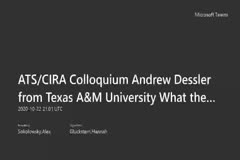
What the Earth’s energy budget tells us about committed warming: Are we already committed to more than 2 deg C?
October 22, 2020
Andrew Dessler from Texas A&M University
Hosted by Maria Rugenstein
Our planet’s energy balance is sensitive to spatial inhomogeneities in sea surface temperature (SST) and sea-ice changes, but this is typically ignored in climate projections. Here we show the energy budget during recent decades can be closed by combining changes in effective radiative forcing, linear radiative damping, and this pattern effect. The pattern effect acts like a negative forcing,…

ATS Cultural Jamboree
October 08, 2020
Jhordanne Jones, Julieta Juncosa Calahorrano, Wei-Ting Hsiao, Alex Sokolowsky, Chaehyeon Chelsea Nam
Hosted by Sagar Rathod
Five student presenters from our department will share their personal experiences of cultural interactions through their academic and social journeys. Talks will be followed by an open panel discussion facilitated by graduate research assistant Sagar Rathod. “Jamaican Cooking with American Ingredients: A Photo Story” Jhordanne Jones “Navigating grad-school in two different…
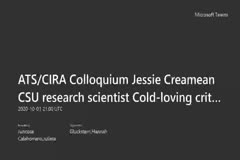
Cold-loving critters: Where do Arctic microbes come from and what do they have to do with clouds?
October 01, 2020
Jessie Creamean, CSU research scientist
Hosted by Sonia Kreidenweis
The accelerated rate of warming in the Arctic is of great concern due to potential impacts that include release of greenhouse gases from permafrost, melting glacial ice contributing to sea level rise, and declining sea ice cover exposing the darker ocean surface. Clouds play a crucial role in regulating the energy reaching the sea ice and snow surfaces, but the magnitude of their effects on…

Climate effects of volcanic aerosol: past and future
September 28, 2020
Anja Schmidt from the University of Cambridge
Hosted by Jeff Pierce
Volcanism is a major driver of climate variability and has played a critical role in the long-term evolution of Earth's atmosphere and habitability through the release of gases including sulfur species, water, carbon dioxide, and halogens. In this talk, I will summarize my work on volcanic sulfur emissions from volcanic eruptions of different styles, magnitudes, and durations. The general…
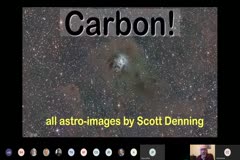
The Curious Case of Carbon: from Cosmos to Carbonate
September 17, 2020
Professor Scott Denning
Hosted by
Original resolution. Carbon and oxygen are made in dying stars, and are the most abundant elements in the universe after hydrogen and helium. The plane of our galaxy is thick with carbonaceous particles which we call “dust” but which are really more like a mixture of smoke and grease. Thousands of organic compounds including all the amino acids…
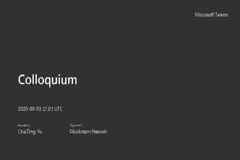
An overview of smoke in Fort Collins in August 2020: Sources, transport, and potential impacts
September 03, 2020
Associate Professor Jeff Pierce
Hosted by Christine Chiu
Original resolution. Wildfires during August of 2020 brought Fort Collins its highest concentrations of particulate matter since the High Park Fire in 2012 and its most sustained smoke exposure in recent history. This smoke period was unique because smoke was both local (e.g. the Cameron Peak fire) and from long-range transport from California, with…
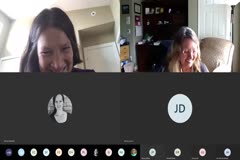
Who's Breathing Whom? Air Transport of Small Particles, Like Viruses
August 27, 2020
Tami Bond, Scott Presidential Chair in Energy, Environment and Health, CSU Department of Mechanical Engineering Professor
Hosted by Sonia Kreidenweis
Original resolution. The last six months of the COVID-19 pandemic have provided many lessons in thinking about contaminant transport. One of the lessons is that the principles of aerosol dynamics are not fully integrated into recommendations to protect public health and reduce exposure. A group of CSU faculty has been working over the summer to…
